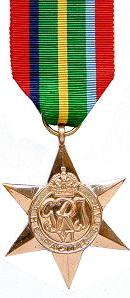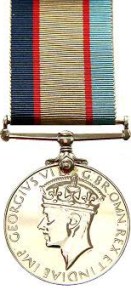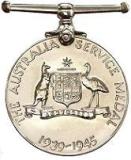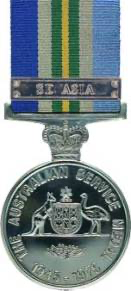Q135357 and QX58292
Lance Sergeant Kenneth Brennan
9th Aust Infantry Training Battalion
61st Australian Infantry Battalion
[27th Australian Infantry Battalion
8th Australian Infantry Battalion
8th Movement Control Group]
This file last updated 26 October, 2025 13:00
Introduction

Kenneth Brennan
Army Photographs
The following information and chronological table are a summary of the entries from the World War Two Service Records of KENNETH (Ken) BRENNAN, b 13 Jun 1922, d 4 Apr 1998 aged 75, buried Maryborough Crematorium Kenneth served in WW2 as Lance Sergeant QX58292 and Q135357 with 61 Aust Inf Bn, 27th Aust Inf Bn and 8th Aust Inf Bn. See his Service Record here.
Ken Brennan serves in the Citizens Military Forces (CMF) from the age of 19½, initially in the 47th Militia Battalion, 29th Australian Infantry Training Battalion and then the 61st Militia Battalion with which unit he goes to NEW GUINEA, more that 60% of the unit having agreed to serve overseas.
His previous experience holds him in good stead with both the Training Battalion and the 61st Battalion, until he contracts malaria in NEW GUINEA in late December. He is returned to AUSTRALIA, moving in and out of hospital and convalescent facilities for ten months until October when he enlists in the Australian Imperial Force (AIF).
Returning to BOUGAINVILLE in Jul 1944 he is detached to 4 Field Regiment Artillery for a short period where readers can be confident that he learned how to direct Artillery support to infantry engagements and then to the 9th Australian Infantry Battalion for some three weeks before being promoted to Lance Sergeant.
He takes part in the unit's engagements in BOUGAINVILLE and TOROKINA before being granted leave in AUSTRALIA. He remains in Australia for some time, and while there is no record to support it, it would seem that he is trained in at least some aspects of the movement of units.
On his return to NEW GUINEA he is transferred to the 27th Battalion and the 8th Battalion and the timing indicates that this is in order to facilitate the return to AUSTRALIA (RTA) of both the 27th and the 8th Battalions before being transferred to the 8th Movement Control Group. These units are displayed in a small font above.
He returns to Australia and is discharged on 6 Jun 1946.
The family is that of William Patrick Brennan b 26 Nov 1892, d 24 Nov 1975, buried Boonah Cemetery and Evelyn Ruth n�e Holm b 20 Dec 1894 in Gympie, d 16 May 1971, who married on 25 Nov 1913. See further detailed information at Brennan Family.
Five men of this family served in WW2 and the other four Service Records can be seen at the following links :
-
Robert Neville Brennan - see his . . . . . . . . . . Military Biography.
-
Donald Henry Charles Brennan - see his . . . .Military Biography.
-
Bernard Brennan - see his . . . . . . . . . . . . . . . Military Biography.
-
William (Bill) Brennan - see his . . . . . . . . . . . .Military Biography.
Abbreviations and Acronyms
Abbreviations or acronyms which have a dotted underline can be expanded by moving the cursor over the term - e.g. WIA. The cursor will be replaced by ? and the expanded abbreviation will be displayed. This is gradually being incorporated into the site, replacing the the current expansion of abbreviations. There may be a discernable delay of about a second before the expansion is first provided.
There is also a separate list of abbreviations which is available through the menu at the top of this page or the hyperlink here. Abbreviations are inconsistent, even within a single occurence where a term is abbreviated.
There are a number of sources for tracing abbreviations used in Australian and New Zealand service records. Those used when operating with the British or US forces can generally be found, especially in World War 1. Abbreviations used solely within Australia in WW2 are most difficult to trace, particularly when they are regional. Sometimes a 'best guess' is the only answer.
Duplicated Pages
Some of the service information may appear to be duplicated although individual occurrences are not in the same order and different abbreviations used. This occurs when the unit and Army records are amalgamated upon discharge or death in Service.
Service Numbers
Service numbers in WW1 were unique to the unit (e.g. Battalion) or Corps (e.g. Artillery). In WW2 Service Numbers were unique to the State in which they were allotted. For further information about identity numbers for Service personnel, see Regimental and Service Numbers
Dates of Occurrence and Reporting
The date of reporting an incident may be hours, days or months after the date on which incident actually occurred.
The original service record is amended only when the incident is reported which means that events are not necessarily recorded in in strict chronological sequence. This is the date shown on the left of the page of the original record, and also on the left in my transcription but readers should note that at times there may be no date of reporting at all, particularly when service personel are repatriated for discharge at the end of hostilities.
To assist the reader, when transcribing the military record I have done my best to record events in their chronological sequence. This is date is on the right of the page of the original record and also on the right in my transcription.
For clarity I have transcribed all dates into the format d MMM yyyy.
Enlistment Details
AUSTRALIAN MILITARY FORCES.
MOBILIZATION ATTESTATION FORM.
To be filled in for all Persons at the Place of Assembly when called out under Part III. or IV. of the Defence Act.
Army Number..................Q125357.......QX58292...............................
Surname.................................BRENNAN........................Other Names......................Kenneth.............................................................
Unit.......................................61 A.I.T.B....................................................................................................................................................
Enlisted for service at........................... Maryborough................................................................................................................(Place)
..............................QUEENSLAND..................................(State)......................8 Apr 1942............................................................(Date)
A
Questions to be put to persons called out or presenting themselves for voluntary enlistment*
|
1. What is your name? |
1. Surname BRENNAN |
|
2. Where were you born? |
2. In or near the town of MARYBOROUGH in the state or country of Q'LAND |
|
3. Are you a British Subject? |
Natural Born |
|
4. What is your age and date of birth |
4. Age 21 yrs 3 months |
|
5. What is your your trade or occupation |
5. (a) Shipyard Labourer |
|
6. Are you married, single or widower? |
6. Single |
|
7. Have you previously served on active servicce if so, where and in what arm? |
7. Yes, Papua. Infantry |
|
8. Who is your actual next of kin? (Order of relationship.— wife, eldest son, eldest daughter, father, mother, eldest brother, eldest sister, eldest half-brother, eldest half-sister) |
8. Name |
|
9. What is your permanent address? |
. 40 Fort St, Maryborough |
|
10. What is your religious denomination? (Answer optional) |
10. R.C. |
I, .....................Kenneth Brennan....................................................................do solemnly declare that the
above answers made by me to the above questions are true and that I am willing to serve in the Australian Military Forces within or beyond the limits of the Commonwealth.
Witnessed by ....................... Worthington Capt.................................K. Brennan..................................
* The person will be warned that should he give false answers to any of these questions he will be liable to heavy penalties under the Defence Act.
B
MEDICAL EXAMINATION
I have made full and careful examination of the abovenamed person in accordance with the instructions contained in the Standing Orders for Australian Army Medical Services. In my opinion he is—*
1. Fit for Class I
2. Temporarily unfit for Class I † ............................................................................................................................................................
3. Fit for Class II.
4. Temporarily unfit for Class II †.................................................................All ...........................................................................................
5. Unfit for military service † ..................................................................................................................................................................
Place ............................................................. Date .............................23 Sep 1941 ........................
Signature of Examining Medical Officer .........................Illegible ................................................................................
* Classifications which are inapplicable to be struck out † Reasons for unfitness to be stated.
C
OATH OF ENLISTMENT ‡
For persons voluntarily enlisted or called upon under Part IV, of the Defence Act to serve in the Citizens Forces in time of war. Not compulsory for serving members of the Forces or those allotted to the Citizen Forces under Part XII. of the Act, but unless in any case an objection is raised, the oath should be administered to them as part of the ceremony of attestation.
I,.....................Kenneth Brennan ...............swear that I will well and truly serve our Sovereign Lord, the King, in the Military Forces of the Commonwealth of Australia until the cessation of the present time of war or until sooner lawfully discharged, dismissed, or removed, and that I will resist His Majesty's enemies and cause his Majesty's peace to be kept and maintained, and that I will in all matters appertaining to my service faithfully discharge my duty according to law.
SO HELP ME GOD!
Signature of Person Enlisted................. K. Brennan .................................................................
Subscribed at ............................... Illegible .............................. in the State of ..........................................................Queensland ............
this ............................ Thirtieth ...................................... day of ..................................September .................................. 1943. ................
Before me—
Signature of Attesting Officer ................................Worthington Capt......................................................................................................
‡ Persons who object to take an oath may make an affirmation in accordance with the Third Schedule of the Defence Act. In such cases the above form will be amended acccordingly and initialled by the Attesting Officer.
Overstamped with "DISCHARGED" and handwritten note "6.6.46" and authorising details.
Chronological Events
(Service and Casualty Form)
|
Date |
Received |
Event/Casualty |
Date of |
Place of |
|
11 Apr 1942 |
NC General Details Depot |
Marched In |
10 Apr 1942 |
BRISBANE |
|
15 Apr 1942 |
28 Inf Trg Bn |
Marched in T.O.S. from NC Gen Details Depot |
12 Apr 1942 |
GOONDIWINDI |
|
25 May 1942 |
29 Inf Trg Bn |
Promoted to L/Corporal |
21 May 1942 |
GOONDIWINDI |
|
9 Jun 1942 |
29 Inf Trg Bn |
To No 4 Section Leaders Course Goondiwindi |
8 Jun 1942 |
GOONDIWINDI |
|
14 Jul 1942 |
D.D.M.S. |
Sick to 47 C.H. Goondiwindi (Rubella) |
14 Jul 1942 |
GOONDIWINDI |
|
9 Aug 1942 |
29 Inf Trg Bn |
|
3 Aug 1942 |
GOONDIWINDI |
|
12 Aug 1942 |
29 Inf Trg Bn |
Promoted to A/Corporal |
8 Aug 1942 |
GOONDIWINDI |
|
6 Sep 1942 |
29 Inf Trg Bn |
M/O transferred to Advanced Reinforcements Depot N.G. |
26 Aug 1942 |
GOONDIWINDI |
|
28 Aug 1942 |
61 Bn |
Embarked "AUSHUN" for DISEMB 2 SEP 1942 |
28 Aug 1942 |
BRISBANE |
|
6 Sep 1942 |
|
M/In from 29 Inf Trg Bn |
29 Aug 1942 |
[Illegible] |
|
12 Sep 1942 |
61 Bn |
M/In from Adv Reinf Depot NG Forces |
9 Sep 1942 |
Field |
|
29 Oct 1942 |
61 Bn |
Promotion Reversion to pay as private at own request |
23 Oct 1942 |
Field |
|
27 Dec 1942 |
DDMS |
Adm 2/1 CCS (Malaria) |
27 Dec 1942 |
Field |
|
2 Jan 1943 |
DDMS |
From 2/1 CCS to MV "DUNTROON" and trans to "X" List. EMB |
2 Jan 1943 |
Field [NEW GUINEA] |
|
7 Jan 1943 |
DDMS |
From SAT [MV] "DUNTROON" to 2/11 AGH. DISEMB |
7 Jan 1943 |
AUST |
|
18 Jan 1943 |
DDMS |
Evac from 22/11 AGH to 102 Conv Depot |
18 Jan 1943 |
AUST |
|
4 Feb 1943 |
7 Aust Inf Trg Bn |
Evac 102 Conv Depot to 7 AITB |
2 Feb 1943 |
AUST |
|
20 Mar 1943 |
112 AGH |
Evac to 112 AGH (rec Malaria) ex 7 AITB |
17 Mar 1943 |
AUST |
|
20 Mar 1943 |
G.D.D. |
Discharged 112 AGH and marched into Q.L. of C. G.D.D. |
20 Mar 1943 |
AUST |
|
21 Mar 1943 |
G.D.D. |
From Q.L. of C. G.D.D. to N.G.F.A.R.D. |
2312 MAR 1943 |
AUST |
|
27 Mar 1943 |
82 A.C.H. |
Evac to 82 A.C.H. (Malaria relapse) ex N.G.F.A.R.D. |
27 Mar 1943 |
AUST |
|
27 Mar 1943 |
116 A.G.H. |
Evac 116 AGH to 114 Conv Depot |
20 May 1943 |
AUST |
|
22 May 1943 |
116 A.G.H. |
Offence: Conduct to the Prejudice of Good Order and Military Discipline. |
19 May 1943 |
AUST |
|
19 Jun 1943 |
114 ACD |
Discharged 114 Aust to N.G.F.A.R.D. |
16 Jun 1943 |
AUST |
|
25 Jun 1943 |
116 A.G.H. |
Evac to 116 Aust Gen. Hosp (Scabies) (ex N.G.F.A.R.D.) |
24 Jun 1943 |
AUST |
|
1 Aug 1943 |
114 ACD |
Evac 116 Aust Gen Hosp to 114 Aust Conv Depot |
31 Jul 1943 |
AUST |
|
6 Aug 1943 |
116 AGH |
Evac 114 Aust Conv Depot t 116 Aust Gen Hosp (PUO ? Malaria) |
6 Aug 1943 |
AUST |
|
21 Aug 1943 |
114 Conv Depot |
Evac 116 Aust Gen Hosp to 114 Conv Depot |
20 Aug 1943 |
AUST |
|
17 Sep 1943 |
114 Conv Depot |
Discharged 114 Aust Conv Depot to 5 Aust Adv Reinf Depot |
17 Sep 1943 |
AUST |
|
4 Oct 1943 |
5 Aust Adv Rec Depot |
Enlistment in AIF Army Number now QX58292 |
30 Sep 1943 |
AUST |
|
7 Nov 1943 |
NG Records |
Embarked at T'VILLE per "HMAS KATOOMBA" on 3 Oct 1943 & Disemb PORT MORESBY by 4 Nov 1943 |
4 Nov 1943 |
NEW GUINEA |
|
8 Nov 1943 |
61 BN |
Taken on Strength from NG Details Depot |
5 Nov 1943 |
NEW GUINEA |
|
7 Jan 1944 |
61 AUst Inf Bn |
Embarked per [HMT] "WILLIAM HUME" |
8 Jan 1944 |
PORT MORESBY |
|
22 May 1944 |
61 Bn |
Granted Proficiency pay |
19 May 1944 |
QLD |
|
4 Jun 1944 |
2/6 AGH |
Evacuated to 2/6 Aust Gen Hospital & trnsfd to X List (PUO? Malaria) |
4 Jun 1944 |
QLD |
|
16 Jun 1944 |
2/6 AGH |
Discharged 2/6 Aust Gen Hosp to 2 Aust Corps Reception Camp (BT MAlaria R) |
16 Jun 1944 |
QLD |
|
17 Jun 1944 |
61 Bn |
Taken on Strength from 2 Aust Corps Reception Camp |
17 Jun 1944 |
QLD |
|
27 Jul 1944 |
61 Aust Inf Bn |
Embarked per "HMAS KATOOMBA" |
20 Jul 1944 |
CAIRNS |
|
7 Sep 1944 |
61 Aust Inf Bn |
Appointed paid Lance Corporal |
|
NEW GUINEA |
|
23 Oct 1944 |
61 Aust Inf Bn |
Promoted |
19 Oct 1944 |
NEW GUINEA |
|
23 Oct 1944 |
61 Aust Inf Bn |
Proficiency pay withdrawn |
19 Oct 1944 |
NEW GUINEA |
|
20 Nov 1944 |
1 Aust Adv 2nd Echelon |
Embarked PER "CAPE VICTORIA" |
10 Nov 1944 |
NEW GUINEA |
|
25 Nov 1944 |
61 Bn |
Detached to 4 Aust Fd Regimentt [Artillery, not to be confused with 4 Australian Field Company, and Engineer unit.] |
21 Nov 1944 |
NEW GUINEA |
|
28 Nov 1944 |
61 Bn |
M/In on cessation of detach to 4 Aust Fd Regt |
26 Nov 1944 |
NEW GUINEA |
|
2 Jan 1945 |
61 Bn |
Detached to 9 Aust Inf Bn |
4 Dec 1944 |
NEW GUINEA |
|
2 Jan 1944 |
61 Bn |
M/In on cessation of detachment |
20 Dec 1944 |
NEW GUINEA |
|
22 Jan 1945 |
61 Bn |
Appointed Lance Sergeant |
22 Jan 1945 |
NEW GUINEA |
|
30 May 1945 |
Qld Echelon & Reception |
Embarked per "HMAS KATOOMBA |
21 May 1945 |
TOROKINA |
|
|
|
Disembarked for recreational leave |
29 May 1945 |
TOWNSVILLE |
|
1 Aug 1945 |
1 Aust Adv |
Emplaned CAIRNS, deplaned PORT MORESBY |
29 Jul 1945 |
CAIRNS |
|
21 Aug 1945 |
2 Echelon |
Emplaned PORT MORESBY, deplaned TOROKINA B'VILLE |
13 Aug 1945 |
B'VILLE |
|
14 Aug 1945 |
61 Bn |
Rejoined Unit from leave |
13 Aug 1945 |
B'VILLE |
|
10 Oct 1945 |
61 Bn |
Transferred out to 27 Bn (A) |
10 Oct 1945 |
B'VILLE |
|
10 Oct 1945 |
27 Bn (AIF) |
Transferred in from 61 Aust Inf Bn |
10 Oct 1945 |
B'Ville |
|
26 Dec 1945 |
27 Bn |
Transferred to 8 Inf Bn |
26 Dec 1945 |
Vic Mob? [Movement document but still in BOUGAINVILLE] |
|
26 Dec 1945 |
8 Bn |
Transferred in from 27 Inf Bn |
26 Dec 1945 |
Vic Mob? [Movement document but still in BOUGAINVILLE] |
|
5 Jan 1946 |
8 Bn |
Trans to 8 Movement Control [Group] |
31 Dec 1945 |
B'VILLE |
|
5 Jan 1946 |
8 Mov Con Group |
TOS from 8 Inf Bn |
21 Dec 1945 |
B'VILLE |
|
8 May 1946 |
8 Mov Con Group |
Transferred to GDD Q'Ld L of C Area for disposal |
19 May 1946 |
QER |
|
|
|
Embarked Rabaul per "MANANUNDA" |
13 May 1946 |
NB |
|
|
|
Disembarked SYDNEY |
19 May 1946 |
NSW |
|
|
|
Discharged from the Army |
6 Jun 1946 |
|
|
6 Jun 1989 |
|
Hand-written letter enquires concerning the issue of the Front Line Service Medal. [He would have learned of this from his brother Brendan who served with the 12th Battalion.] |
8 Jun 1989 |
|
|
21 Jun 1990 |
|
Response states that this is not issued by the Australian Army and has been struck bythe Queensland Branch of the 2nd/12th Australian Infantry Battalion Association and suggests he contact the honorary secretary. |
Jun 1989 |
NSW |





